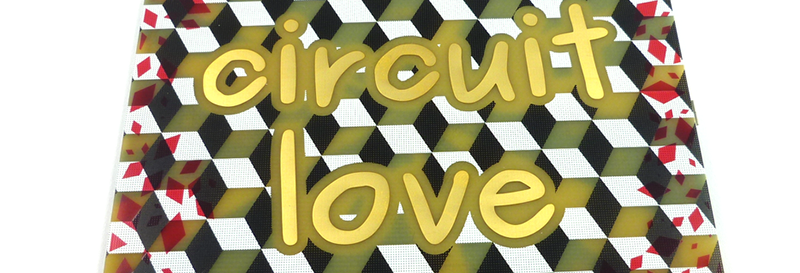The cheapest PCBs – and therefore most common – are green solder mask with white silkscreen. It works, but it’s also incredibly boring. This is the way things were done up until a few years ago with the explosion of board houses trying to compete for your Yuan, and now getting a red, yellow, black, blue, green, and even OSH purple is possible. This doesn’t mean multiple solder masks aren’t possible, as [Saar] demonstrates with his demonstration of multicolor solder masks and circuit love.
We’ve seen a lot of [Saar]’s designs, including a mixing desk, a cordwood puzzle, and an engineer’s emergency business card, but so far his artistic pieces have been decidedly monochromatic. For this build, [Saar] teamed up with Eurocircuits to create a board that exploits their capabilities.
Althought Eurocircuits has PCB PIXture, a tool for putting graphics on PCBs, [Saar] made this with his own tool, PCBmodE. The design of both the red and yellow variants are abstract, and only meant to be a demonstration of what can be done with multicolor solder mask. It looks great with five backlit LEDs, and with an acrylic top and bottom, makes a great coaster or art piece.
We like [Saar’s] work so much that we put his Cordwood puzzle in the Hackaday Store.















Wow! Thanks for posting this. I’m Saar ;)
The design is a ‘regular’ PCB design created with PCBmodE, http://pcbmode.com , which produces Gerbers given to Eurocircuits. Only the ‘red’ variant used Eurocircuit’s PCB PIXture technique.
Man this is awesome. I hope Eurocircuits will soon allow us to order that kind of board at a reasonable price.
I like this. I hope it will be used for good things (colorcoding parts, small Logos, etc.) and not for things like in the example. It would serious mess with my eyes looking at a board like that for too long.
I once saw a domestic TV PCB with multicoloured silk-screen on the top side to distinguish various signal paths and power supplies. It was a very old TV at the time, in the 1970s. In fact, it was made from valves (vacuum tubes), not transistors.
Small nitpick (I’m helping! ), when you say “compete for your yen”, I assume your referencing the Chinese board houses. Yen is Japanese currency, Yuan is Chinese. Or maybe I’m wrong, feel free to correct me.
Good catch. Fixed.
Small fact! Both Yuan and Yen have the same etymology!
Yup. For those too lazy to look, they both came from the Chinese “yuán” (圓) meaning “round”, as in the shape of coins. Chinese now use 元, and Japanese [mostly] 円, though both very similar pronunciation (to most western ears, anyway). It’s crazy closely related those languages are.
Nice solder mask!
I learned something new today!
Are there any art tools like this that you can use to ‘accent’ designs created in other tools? I’d like to do more fun stuff on my boards but I’ve avoided trying since it seems like I’d spend more time on that than the actual circuit.
Saar’s tool fundamentally uses inkscape as the drawing machine. Its a great Vector package. check it out. Anything you do in there can be incorporated in PCBMode
If the soldermask is layered then perhaps it might be possible to build up square indentations in the board that could hold BGA parts in place during reflow, it would make BGA parts a lot more accessible to the average tinkerer.
Brian—I’m not normally the nitpick-at-the-article type, but for Saar’s sake you ought to see his comment to this article (the first in the article). He didn’t use Eurocircuit’s pre-made PIXture function, but he used his self-made PCB software, PCBmodE, which deserves mentioning in the article; it’s rather clever and unusual and perhaps deserves an article in its own right.
Having had a play with PCBmodE it’s fascinating stuff; you specify your nets and parts declaratively using JSON, then draw them all on an SVG using Inkscape of all things. There’s really nothing else like it. I’d love to use it more regularly myself but I started out as a software guy and I still rely rather heavily on DRC for even simple PCBs, so I can’t quite give away KiCad just yet…
Thanks for the kind words and clarification! ;) Please get in touch with me regarding your experiences with PCBmodE.
PCBmodE is brilliant. I started trying to improve the integration with Inkscape but ran out of resources. Hoping to get back to my clone soon.